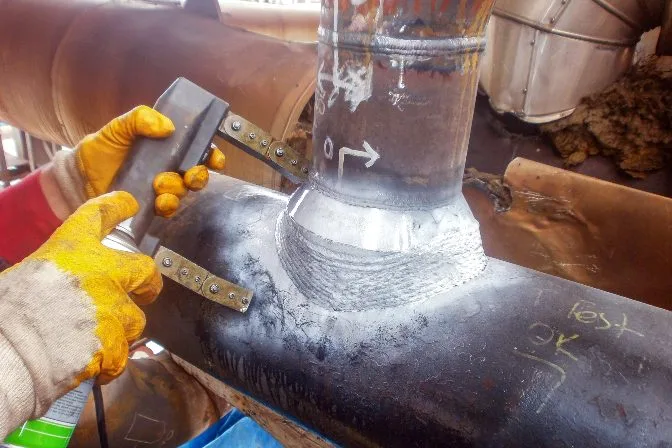A Thorough Summary of Container Welding Inspection Specifications and Methodologies for Improved Weld Quality and Efficiency
The significance of welding inspection standards in the production of containers can not be overemphasized, as they offer as the foundation for making sure weld stability and operational reliability. Various inspection methods, consisting of visual assessments and progressed non-destructive screening techniques, are vital in determining potential flaws that can endanger efficiency.
Importance of Welding Examination Specifications

Welding examination standards incorporate a series of criteria, consisting of product specs, welding procedures, and qualifications of employees entailed in the welding process. By imposing these criteria, organizations can methodically identify and remedy possible flaws, therefore reducing the likelihood of expensive fixings or devastating failings. Furthermore, extensive examination practices promote a society of accountability and accuracy, urging welders to maintain high levels of workmanship.

Common Welding Inspection Strategies


Ultrasonic Testing (UT) is another widespread strategy, using high-frequency sound waves to spot internal flaws that might not show up on the surface. This method is particularly effective for recognizing spaces or additions within the weld metal. Magnetic Fragment Checking (MT) is likewise widely made use of, specifically for ferromagnetic materials, as it reveals surface area and near-surface flaws through the application of magnetic fields and ferrous fragments.
Furthermore, Liquid Penetrant Screening (PT) finds surface-breaking problems by applying a penetrant to the weld and afterwards using a programmer to extract the penetrant. Each of these methods contributes to a comprehensive examination technique, ensuring that welds fulfill the strict quality criteria required in container building.
Governing Specifications and Compliance
Regulative standards and conformity are important parts in guaranteeing the safety and dependability of bonded structures in container building - Tank Welding Inspection. These criteria serve to develop minimum requirements for material properties, welding treatments, and inspection methods, therefore decreasing the threat of structural failures and boosting overall performance
Trick organizations, such as the American Society of Mechanical Designers (ASME) and the American Welding Society (AWS), offer standards that are widely embraced in the sector. Conformity with these standards not just makes certain adherence to best methods but likewise fulfills lawful and contractual responsibilities, guarding the this interests of stakeholders.
Regulative bodies commonly mandate adherence to specific codes, such as ASME Code Section IX for welding credentials and API 650 for welded tanks. These codes detail needs for welding strategies, qualifications of personnel, and testing techniques to validate weld honesty.
Regular audits and evaluations are vital to keeping conformity, as they aid recognize deviations from established standards. Non-compliance can cause significant charges, task delays, and safety risks. Thus, a robust understanding of regulative criteria and a dedication to conformity are paramount in achieving high-grade and sturdy bonded container frameworks.
Non-Destructive Checking Techniques
Exactly how can the stability of welded structures be assured without causing damages? Non-destructive screening (NDT) techniques use a robust service, enabling inspectors to evaluate weld top quality without endangering the product - Tank Welding Inspection. Among the most usual NDT strategies are ultrasonic screening (UT), radiographic testing (RT), magnetic particle screening (MT), and color penetrant testing (PT)
Radiographic testing entails passing X-rays or gamma rays through the weld, creating images that reveal architectural issues such as splits or voids. This method is very useful for assessing the stability of complicated welds.
Magnetic bit testing is suited for ferromagnetic products, where magnetic fields disclose surface area and near-surface interruptions. Dye penetrant screening utilizes a fluid dye to highlight surface-breaking problems, making it an effective approach for non-porous materials.
Each of these NDT techniques has distinct benefits, enabling detailed assessments tailored to details materials and welding procedures. By implementing these methods, markets can make certain the dependability and safety and security of bonded structures, eventually boosting overall performance.
Enhancing Weld Top Quality With Examination
Effective evaluation plays a go to this web-site critical function in boosting weld quality, serving as an essential checkpoint in the fabrication process. By determining possible defects early, evaluations alleviate the threat of compromised structural stability and make sure conformity with sector standards. Employing a combination of visual assessments, non-destructive screening (NDT) approaches, and mechanical analyses, inspectors can spot problems such as porosity, fractures, and insufficient combination.
Applying a durable examination method not just improves the overall quality of welds but also fosters a culture of accountability among welders and fabricators. Regular training and certification of evaluation personnel guarantee that they are geared up with the required skills to recognize and address potential problems effectively. This proactive strategy decreases rework and linked prices, eventually adding to project site efficiency.
Furthermore, comprehensive documents of examination searchings for supplies important insights right into reoccuring problems, helping with continuous renovation in welding techniques. By leveraging sophisticated technologies, such as automated ultrasonic testing or electronic radiography, weld high quality can be enhanced via a lot more accurate evaluations. Finally, a strenuous evaluation process is crucial in accomplishing premium welds, ensuring safety and security, dependability, and longevity in container construction.
Conclusion
Finally, the implementation of strenuous storage tank welding inspection requirements and approaches is crucial for making sure weld integrity and efficiency. By utilizing a mix of visual assessments, non-destructive testing techniques, and adherence to regulatory requirements, organizations can successfully identify and alleviate possible problems. Cultivating a culture of liability among welders additionally boosts the high quality of welding procedures. Ultimately, these methods add to decreased architectural failings, lower repair service costs, and enhanced functional efficiency within the market.